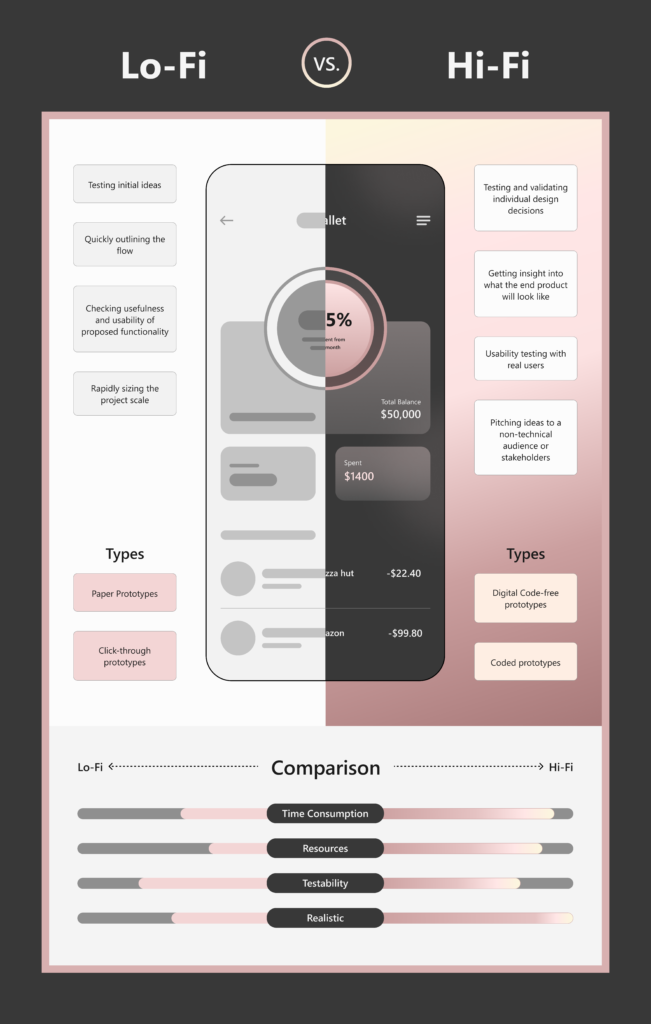Table of Contents
Overview
Strategic Approach Needed:
- Achieving success in product development hinges on mitigating risks while maximizing value.
Key Methodologies:
- Prototyping: Validates ideas and collects feedback.
- Minimum Viable Product (MVP): Facilitates quick iteration and refinement
Article Focus:
- Understanding Prototyping and MVP
- Comparing a Prototype and an MVP
- Different scenarios outlining the best times and ways to use each
- Real world examples of each
Understanding Prototyping
- Definition of Prototyping: Prototyping transforms an idea into a tangible product, enabling testing, refinement, and early identification of potential issues before proceeding to full-scale production.
- Types of Prototypes:
- Low-Fidelity Prototype: Low-Fidelity Prototype: Simple sketches or wireframes that highlight the structure, without delving into design details.
- High-Fidelity Prototype: Interactive models with a more accurate representation of the user interface, design, and user flow.

MVP Development: The Path to Market
- Definition of MVP:
- The most basic version of a product for early adopters.
- Focuses on essential features that address a specific problem and deliver immediate user value.
- Approach:
- Lean and efficient.
- Aligns with agile development principles

The Balanced MVP Approach
A balanced approach to MVP development can be visualized through two contrasting pyramids
- The left pyramid shows an MVP where all layers (functional, usable, appealing, and great design) are present, but in manageable portions. This leads to a core set of features done well, ensuring users get a usable and appealing product with potential for further iterations.
- The right pyramid shows the flawed approach of prioritizing many features done poorly. A product that has lots of features but fails in usability and design might seem impressive, but it’s often clunky and frustrating to use.
Key Differences Between Prototype and MVP
| Aspect | Prototype | MVP |
| Objective | Checks the feasibility of the idea by evaluating the design and its UI/UX | Validate market fit by gathering feedback and testing core functionality |
| Features | Basic, low fidelity, limited functionality | High fidelity, includes essential features to address user needs |
| Development Speed | Built quickly, often using simple technology | Takes longer to develop in comparison to a prototype |
| User Base | Small group of users for initial feedback | Broader target audience for real-world testing |
| Cost | Lower cost, often not intended for long-term use | Higher investment, but serves as the foundation for further development |
| Result | Helps refine the idea for future development | Gathers insights from users to guide iteration and improvements |
| Technical Complexity | Simple, primarily centred around front-end design with limited functionality | More complex, with both front-end and back-end functionality implemented |
| Risk Level | Lower risk, as it’s used only for concept validation | Higher risk due to market exposure but essential for gathering real-world insights |
| Longevity | Short-term; typically discarded or significantly altered after testing | Long-term; forms the basis for the final product, iterated over time |
| Example | A simple clickable wireframe or design mock-up of a mobile application | A functional music streaming app with core features like browsing and playback |
When to Use a Prototype
- Idea validation: Visualizing early ideas or features before committing to development.
- Stakeholder buy-in: Demonstrating the concept to investors or stakeholders.
- Design feedback: Refining the user experience and interface.
- Technical feasibility: Testing the feasibility of complex interactions.
Prototype Examples:
Facebook’s “Like” Button Evolution:
The well-known “Like” button was not yet implemented when Facebook was in its early days. The team developed several prototypes, experimenting with different terms (“Like,” “Love,” “Awesome”) and visual designs (thumbs-up, heart, star). Based on user feedback, they ultimately chose the blue thumbs-up icon that we recognize today.

When to Use an MVP
- Market validation: Testing customer demand for a new product.
- Customer feedback: Gathering insights from actual user interactions to guide future iterations.
- Launching new features: Releasing a subset of features to evaluate their performance before full implementation.
MVP Examples:
Uber’s MVP Success:
Initially launched as UberCab, Uber sought to solve the problem of finding taxis efficiently. The first version of the app, available only via email invitation, allowed users to connect with cab drivers and pay via credit card. This Minimum Viable Product included simple graphics and fundamental features. Fancy features, like in-app payments, were added later after the app gained traction and downloads.

Conclusion
Prototypes and MVPs are both integral to product development. While a prototype aids in visualizing and testing ideas at an early stage, an MVP validates these concepts with real users in the marketplace Understanding when and how to use each can help organizations innovate faster, reduce risk, and ultimately deliver products that better meet market demands. By leveraging both strategies effectively, companies can ensure that they are not only building the right product but doing so with the least amount of wasted resources and effort.
Image sources:
- Prototyping vs MVP
https://media.dev.to/cdn-cgi/image/width=1000,height=420,fit=cover,gravity=auto,format=auto/https%3A%2F%2Fdev-to-uploads.s3.amazonaws.com%2Fuploads%2Farticles%2F9ng7wav7hs0i6dtz24ry.png
- Facebook Like button:
https://commons.wikimedia.org/wiki/File:Facebook_Like_Button.jpg
- Uber Logo:
https://assets.uber.com/d/k4nuxdZ8MC7E/logos/show/eyJpZCI6NTUxMCwidGltZXN0YW1wIjoiMTcyNTk2MTEzNyJ9:postmates:g3mI0ASaUM45gD7eoq_Xq0SIP-_6j41n_QI5LCoEkC0
Learn more on MVP – Minimum Viable Product (MVP): Essential Guide for Successful Launches | Byteridge








